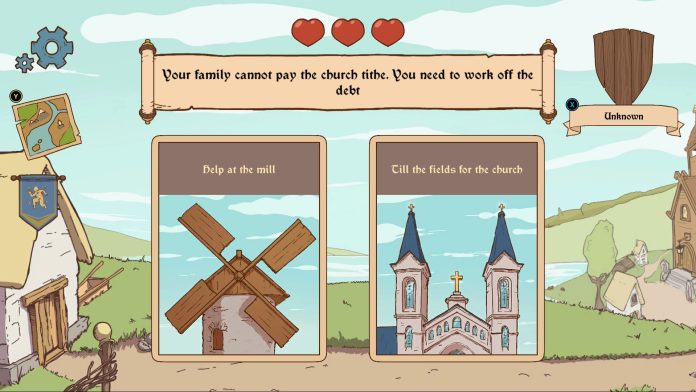Our ability to choose based on rationality, deduction and information is one of the things that has elevated us humans to the dominant species on Planet Earth. Sometimes the results are unexpected, but we are also gifted with the ability to learn from our mistakes and adapt.
We are forever making decisions, and Choice of Life: Middle Ages is a game centred around this concept. Inspired by the Choose Your Own Adventure and Fighting Fantasy books that were all the rage in the 1980s, your task is simple: Make your way from peasant to nobleman by any means necessary. Not all of the decisions are altruistic, you may need to beg, steal and borrow to get there or even call in a favour from some otherworldly beings.

Things start peacefully enough; even as a baby you are making decisions like whether to walk or talk first. The opening moments of Choice of Life: Middle Ages are designed to test you. You have three lives on your adventure, and wrong decisions can remove them. They can also be replenished.
If you have ever read one of the aforementioned books then you will know what to expect here, but Choice of Life: Middle Ages does play like an even more basic version of them. A small piece of text will briefly describe what is happening – there is no animation to visually show this – and your presented options will appear below. Choice of Life: Middle Ages lacks the descriptive language you would find in the books. It also has a nasty habit of throwing choices at you with very little cohesion in the early stages. Later sections – namely once you have made it into the city – follow a much better storytelling beat.
Dying is almost guaranteed but doesn’t necessarily mean your attempt is over. Instead, you make a deal with the devil who wants to get into the castle treasury. In there is something you need to get, in order to give them their full power back.
Die again after making this deal and you will be resurrected but at the start of the chapter, requiring you to replay through sometimes vast sections again.

All roads lead to this conclusion. But how you get there – and also what you do there – can vary wildly. During my first playthrough, I earned access to the castle by being the court jester. In another, I was head priest of the monastery. Most decisions you make have a logical conclusion: for example, pulling the horse’s tail in the early moments will end as well as you expect, whilst approaching a shadowy figure is never a good idea. There are only one or two examples where a conclusion is illogical, so you can apply some common sense to the scenarios.
On your quest, you will pick up titles for doing various deeds. Unfortunately, these don’t do much. There is a screen where you can view the ones you have unlocked and the associated crests, but you can only ever see the latest one you have unlocked on the main game screen. Having the ability to display a specific one you are proud of, or even titles granting some sort of bonus would have been a better application.
A map can also be accessed detailing your route to the castle, and once you have unlocked a specific path you can restart from that point rather than having to go back to the beginning each time.
Choice of Life: Middle Ages also makes it a bit easier to replay again to get a different ending. Decisions you have already made in previous playthroughs will appear as green options. Choices you have previously made but can offer other resolutions will appear as blue options. As you look for alternate routes to the city and different achievements, these highlighted answers can be very helpful.

Speaking of achievements, Choice of Life: Middle Ages has nineteen of them. Unsurprisingly, there are multiple endings to discover, and achievements associated with some of them. There are also some achievements for finding all the titles and completing some more unusual substories that may be otherwise hard to discover. As a full 1000G completion, it may take slightly longer than say a Ratalaika Games title, but through a few playthroughs, and choosing different options, you should still have this completed within a few hours.
Choice of Life: Middle Ages takes the popular medium of those Choose Your Own Adventure books and applies this to a videogame. And a bare bones videogame at that, stripping away most of the good stuff and just leaving a procession of decisions to make in quick succession. There isn’t so much a game here; instead you’ll be left reading and choosing A or B. Attempts have been made to make it more fun – not having to restart from the very beginning each time, for instance – but there is so little else here.
Moving pictures, descriptive language or even a bit of a longer scenario would have all helped make Choice of Life: Middle Ages more enjoyable.
Try and survive medieval times in Choice of Life: Middle Ages from the Xbox Store







